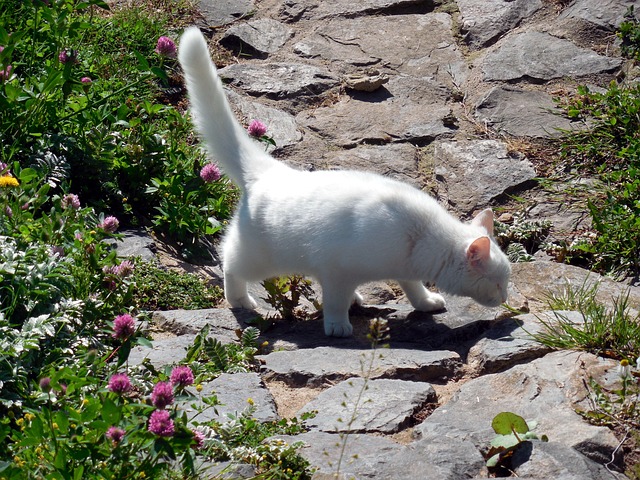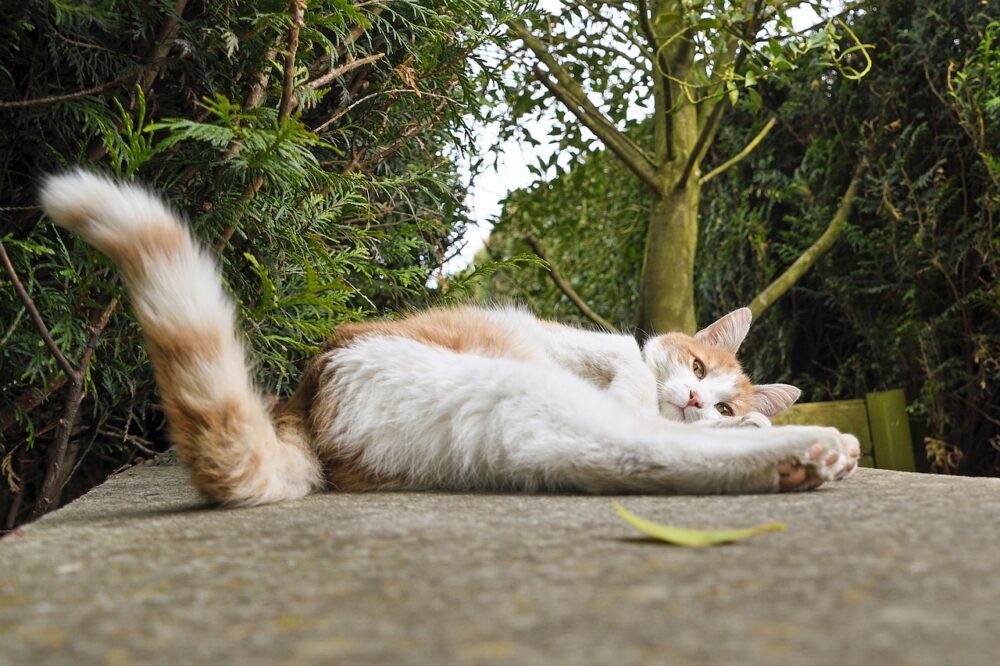As a cat owner, you probably already know that cats communicate a lot through body language. In fact, cats only meow at us because they understand that it is the easiest way to get our attention. In the wild, cats only meow as kittens, and once they grow up, they don’t meow nearly as much as they once did.
Cats will primarily communicate through body language, and it is important as a cat owner to understand the body language of your companion as they will communicate a lot of emotions through seemingly minor changes in body language.
In this article, I will explain why cats wag their tails and the different kinds of emotions that cats communicate via their tails and body language.
You will be surprised by how much you can understand what your cat is feeling at a particular moment just by looking at its body language. With a good understanding of the cat’s body language, you will instantly be able to identify if your cat is feeling happy, anxious, or excited.
So now that we have that out of our way, let’s take a quick look at the different tail movements that cats have so that we can get a more in-depth understanding of them.
Different tail positions for cats
Cats make subtle changes in their tail positions when they feel a certain way. Let’s take a look at the different kinds of emotions your cat conveys through its tail.
Cats wag their tails
Cats will actually wag their tails for multiple emotions. To understand exactly why your cat is wagging its tail, you will need to be able to pick up clues from more than just the tail movement of your cat.
For example, a cat can wag its tail when it is feeling playful, they even wag their tails when they’re hunting or fighting. Tail wagging is not necessarily a sign of a singular emotion.
Let’s take a more detailed look at the different situations in which a cat may wag their tail.
Tail wagging when playing
Cats play so that they can release the excess energy that they have stored in their bodies. They will move around the house quickly, climb objects, and practice hunting.
You may have noticed that quite often, your cat will also be wagging its tail while it is playing like that.
In such cases, the tail wagging is just a way for the cat to express their excitement. They release a bit more of that extra energy when they wag their tails.
It is much like an excited child running around the house when they feel energetic.

Tail wagging when hunting
Cats also wag their tails when they are hunting. The movements in such cases are very light and twitchy. This is especially noticeable when your cat is birdwatching through a window.
Cats often get so focused on their prey that they instinctively try to mimic some of their predatory postures. It is also a form of expressing excitement in this case.
There is also another type of tail movement that cats often have when they are hunting. Cats will “swish” their tail slowly from side to side. This movement is usually followed by a sudden pounce on whatever your cat was hyperfocused on.
Tail wagging for greeting
This is a very subtle movement; Cats will lift their tails straight and have a bit of a curve at the top when greeting or being happy to see someone.
They will often also incorporate a slight wag at the tip of their tail. This is a friendly gesture by your cat, and you should certainly be glad that your cat is happy to see you!
Tail wagging when irritated
Irritated cats will wag their tails quite often. In such cases, the movement is not uniform or in quick succession. This form of movement is quite similar to when a cat is hunting, so how can you identify which is which?
Well, it is quite easy to tell them apart if you look at other signs. A hunting cat will be hyper-focused on a particular thing and continuously track it. In addition to that, their body posture will either be in a relaxed position or one where they are ready to pounce.
Cats will also bring their ears forward when hunting; this allows them to hear their prey even better when they are hunting.
On the other hand, if your cat is irritated, it will not be in a relaxed body position. They will also not necessarily be focused on a particular object unless they are about to pounce.
In addition to that, they will also give vocal cues when they are irritated. They will meow and hiss to express their anger or discomfort.
It is natural for your cat to be slightly annoyed at times. Give your cat some space, and they should be back to their usual happy mood soon.
Tail wagging when overstimulated
This does not happen very often, but cats will thump or wag their tails slightly when they are feeling overstimulated. Usually, it may happen when you are petting your cat.
Now, this movement also occurs when your cat is excited and ready to play. So, how can you easily identify if your cat is overstimulated, needs space, or is in a playful mood?
You can tell by just bringing a toy near your cat. If the movement is out of excitement and a playful mood, then your cat will immediately start playing with the toy.
On the other hand, overstimulated cats will ignore the toy as they need some space to relax for a little bit. In such cases, you should let your cat have its own space so that it does not get irritated.
These are all situations in which cats will wag their tails to express a certain kind of emotion. But there are also different ways that cats will use their tails to express feelings.
Let’s also look at the different tail positions cats will use when feeling a certain way.
More tail positions
1. Upright Tail
As I mentioned before, an upright tail signifies a happy cat. Most commonly, if a cat has its
tail in this position, then it is happy to see you and wants to greet you. Cats with upright tails are confident and are in a good mood
Let your cat know that you are also glad to meet them by petting them a little and showing them affection.
2. Upright Tail With Curve
This is also another greeting sign. Cats will have their tails in this position when they are feeling confident and also a little curious. Overall, we can say that a cat with an upright tail is in a really good mood.
3. Fluffy Tail
A fluffy tail is a bad sign; this is an excellent indicator that a cat is threatened by something or feels afraid. The reason that cats fluff their tails is so that they can look bigger to a potential threat.
You should avoid approaching a cat with a fluffed tail so that it may not get even more scared; you can help by identifying what may be causing them to react this way and trying to move some things around near the cat so that the environment changes a little.
Let your cat relax in this case, and try to find out what is causing it to get so fearful.

4. Tail Between Legs
This is also a sign of a tense cat. In such cases, your cat isn’t necessarily thinking that it is about to get attacked at any moment, but it is a little apprehensive about something.
When a cat has its tail between its legs, it also indicates that it is anxious but does not expect to get attacked immediately.
5. Flat Tail
A flat tail can be thought of as a neutral pose. It does not necessarily indicate strong emotion. Quite often, it indicates that your cat is curious and perhaps a little defensive as well. Your cat is not necessarily feeling confident or afraid in such cases. The cat may not feel threatened by something in particular but is also a bit unsure about its surroundings.
I’m sure you are surprised to know that you can identify so many emotions of a cat just by looking at its tail. Cats love to communicate by body language; a good owner will always be on the lookout for different signs to check what their feline friend is feeling at a particular moment.
You can also look at the different body postures cats have while they are feeling a certain way.
Combined with their tail movements, this will be a surefire way to identify your cat’s emotions. There is a general rule to understanding what different body postures express. Usually, when a cat is threatened, it will lower its back and will be in a position to pounce or run away. If the cat is especially afraid, then it will also puff up its body to look bigger.
On the other hand, relaxed cats have much more varied body postures. The most popular position for a cat to be in when it is relaxed is called “Loafing.” Cats usually tuck their back and front legs under their body and sit down with their tails tucked to the side, resembling a loaf of bread. Hence this position is known as “Loafing.”
A loafing cat is, of course, very comfortable and confident. It completely trusts its environment and has nothing to worry about.
Final Thought
Cats are very expressive creatures, but they have very different ways of expressing those emotions.
It can be quite difficult for humans to understand their body language, but it is also important for us to have a good understanding of their cues so that we can react accordingly. One of the most important factors in a cat’s body language is its tail. Cats express a lot of emotions through their tails.
They will wag their tails when they are feeling strongly about particular emotions. In fact, cats wag their tails for almost every emotion. When hunting, cats will wag their tail slowly and will also twitch them slightly. This is because they are trying to mimic their prey’s movements.
A happy or overly energetic cat will wag its tail to let out that excess energy that is built up in its body. The movement, in this case, is quick and very frequent. Cats also wag their tail slightly when they are greeting someone they like. They will have an upright tail and wag the tip just a little in this case.
Irritated cats will wag and thump their tails to express their discomfort with something. It is usually also followed by vocal cues like hissing or meowing.
Overstimulated cats have a tail movement that is quite similar to playful cats. In order to easily tell apart the two emotions, you can try to introduce a toy to the cat; an overstimulated cat will most likely ignore the toy as it just wants to relax for a bit.
You can use many ways to identify your cat’s emotions. But the tail is one of the most critical factors in the whole equation.
You will understand your cat much better if you recognize what the different tail movements mean.
